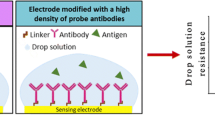Abstract
In this work, we perform three dimensional finite element simulations on the binding reaction kinetics of the commonly used analyte–ligand protein pairs, namely, C-reactive protein (CRP) and anti-CRP, in a reaction chamber (microchannel) of a biosensor. For the diffusion limited binding biomolecular pairs, due to the slower transport speed of the analyte and the faster reaction rate of analyte–ligand complex, diffusion boundary layers often develop on the reaction surface. To enhance the performance of a biosensor by accelerating the transport speed, a non-uniform AC electric field is applied to induce the electrothermal force to stir the flow field. The swirling flow in the fluid can accelerate the transport of the analyte to and from the reaction surface and hence enhance the association and dissociation of analyte–ligand complex. Four types of biosensors with different arrangements of the geometric locations of the electrode pair and the reaction surface are designed to study the effects of varying geometric configuration on the binding efficiency. The simulation results show that the performance of a biosensor can be better improved by placing the electrodes and the reaction surface on the same side of the microchannel against the opposite side. For the best case studied in this work, the maximum initial slope of the binding curve can be raised up to 6.94 times (with respect to the field-free value) in the association phase, under applying AC field of 15 Vrms and operating frequency of 100 kHz. Another important result with applying electrothermal effect is that it is feasible to use the slower sample flow in the microchannel to save a lot of sample consumption without sacrificing the performance of a biosensor. Several control factors not studied in our previous works such as the thermal boundary condition and the effect of electrical conductivity are also discussed.












Similar content being viewed by others
References
Yallow RS, Berson S (1959) Assay of plasma insulin in human subjects by immunological methods. Nature 184:1648–1649
Auroux PA, Iossifidis D, Reyes DR, Manz A (2002) Micro total analysis systems. 2. Analytical standard operations and applications. Anal Chem 74:2637–2652
Tillet WS, Francis T (1930) Serological reactions in pneumonia with a non-protein somatic fraction of pneumococcus. J Exp Med 52:561–571
Camillone N (2004) Diffusion-limited thiol adsorption on the gold (111) surface. Langmuir 20:1199–1206
Deen WM (1998) Analysis of transport phenomena. Oxford University Press, New York
Hibbert DB, Gooding JJ (2002) Kinetics of irreversible adsorption with diffusion: application to biomolecule immobilization. Langmuir 18:1770–1776
Yang CK, Chang JS, Chao SD, Wu KC (2008) Effects of diffusion boundary layer on reaction kinetics of immunoassay in a biosensor. J Appl Phys 103, article # 084702
Sigurdson M, Wang D, Meinhart CD (2005) Electro-thermal stirring for heterogeneous immunoassays. Lab Chip 5:1366–1373
Ramos HM, Castellanos A (1998) AC electrokinetics: a review of forces in microelectrode structures. J Phys D Appl Phys 31:2338–2353
Pethig R (1996) Dieletrophoresis: using inhomogeneous AC electrical fields to separate and manipulate cells. Crit Rev Biotechnol 16:331–348
Ramos A, Green N, Gonzalez AC, Morgan H (2000) Fluid flow induced by nonuniform ac electric fields in electrolytes on microelectrodes, II. A linear double-layer analysis. Phys Rev 61–4:4019–4028
Green N, Ramos A, Gonzalez A, Morgan H, Castellanos A (2000) Fluid flow induced by nonuniform ac electric fields in electrolytes on microelectrodes, I. Experimental measurements. Phys Rev 61(4):4011–4018
Meinhart C, Wang D, Turner K (2003) Measurement of ac electrokinetic flows. Biomed Microdevices 5–2:139–145
Wang XB, Huang Y, Gascoyne PRC, Becker FF (1997) Dielectrophoretic manipulation of particles. IEEE Trans Ind Appl 33:660–669
Morgan H, Hughes MP, Green NG (1999) Separation of submicron bioparticles by dielectrophoresis. Biophys J 77:516–525
Washizu M, Suzuki S (1994) Molecular dielectrophoresis of biopolymers. IEEE Trans Ind Appl 30:835–843
Wang D, Sigurdson M, Meinhart CD (2005) Experimental analysis of particle and fluid motion in ac electrokinetics. Exp Fluid 38:1–10
Feldman HC, Sigurdson M, Meinhart CD (2007) AC electrothermal enhancement of heterogeneous assays in microfluidics. Lab Chip 7:1553–1559
Huang KR, Chang JS, Chao SD, Wu KC, Yang CK, Lai CY, Chen SH (2008) Simulation on binding efficiency of immunoassay for a biosensor with applying electrothermal effect. J Appl Phys 104:064702/11
Yang CK, Chang JS, Chao SD, Wu KC (2007) Two dimensional simulation on immunoassay for a biosensor with applying electrothermal effect. Appl Phys Lett 91 article # 113904
Stratton JA (1941) Electromagnetic theory. McGraw Hill, New York
Landau LD, Lifshitz EM (1959) Fluid mechanics. Pergamon, Oxford
Langmuir I (1918) The adsorption of gases on plane surfaces of glass, mica and platinum. J Am Chem Soc 40:1361–1403
Green NG, Ramos A, Gonzalez A, Castellanos A, Morgan H (2001) Electrothermally induced fluid flow on microelectrodes. J Electrost 53:71–87
Hokama Y, Coleman MK, Riley RF (1965) An agar interaction in immunodiffusion. J Immunol 95:156–161
Behravesh E, Sikavitsas VI, Mikos AG (2003) Quantification of ligand surface concentration of bulk-modified biomimetic hydrogels. Biomaterials 24:4365–4374
Chou C, Hsu HY, Wu HT, Tseng KY, Chiou A, Yu CJ, Lee ZY, Chan TS (2007) Fiber optic biosensor for the detection of C-reactive protein and the study of protein binding kinetics. J Biomed Opt 12:024025-1–024025-9
(2008) Comsol Multiphysics Version 3.4, COMSOL Ltd., Stokhelm, Sweden
Acknowledgments
This research was supported by the National Science Council in Taiwan through NSC 97-2221-E-002-017-MY3 and National Taiwan University CQSE 97R0066-69. We thank the NCHC in Taiwan for providing computing resources.
Author information
Authors and Affiliations
Corresponding author
Rights and permissions
About this article
Cite this article
Huang, KR., Chang, JS. Three dimensional simulation on binding efficiency of immunoassay for a biosensor with applying electrothermal effect. Heat Mass Transfer 49, 1647–1658 (2013). https://doi.org/10.1007/s00231-013-1214-z
Received:
Accepted:
Published:
Issue Date:
DOI: https://doi.org/10.1007/s00231-013-1214-z




